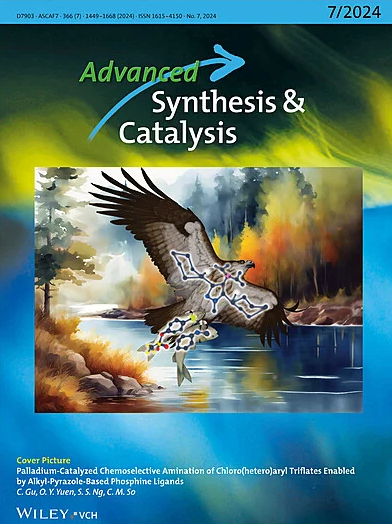Stereoselective Access to γ,γ‐Dihalo‐β‐Enols From Alkynes Combining Visible Light and Biocatalysis
IF 4
2区 化学
Q2 CHEMISTRY, APPLIED
引用次数: 0
Abstract
Merging different strategies in one‐pot processes is attracting considerable attention due to their straightforward and sustainable potential for synthesizing novel organic compounds. In particular, the exquisite selectivity displayed by enzymes and the possibility of coupling biotransformations with metal‐, photo and electrocatalytic processes open new avenues for stereoselective synthesis. Herein, the preparation of chiral (hetero)aryl‐3,3‐dihalopro‐2‐en‐1‐ols is described for the first time. To achieve this, a photochemical and biocatalytic one‐pot sequence is developed, employing visible light irradiation and stereoselective alcohol dehydrogenases (ADHs) for the transformation of commercially available alkynes into optically active compounds in an aqueous medium. The one‐pot, two‐step sequential approach involves a photocatalyst‐free reaction between terminal and internal alkynes with polyhalomethanes, leading to结合可见光和生物催化从炔烃中立体选择性获得γ,γ -二晕- β -烯醇
在一锅工艺中合并不同的策略吸引了相当多的关注,因为它们在合成新型有机化合物方面具有直接和可持续的潜力。特别是,酶所表现出的精细选择性以及与金属、光和电催化过程耦合的生物转化的可能性为立体选择性合成开辟了新的途径。本文首次报道了手性(杂)芳基- 3,3 -二卤丙- 2 -烯- 1 -醇的制备。为了实现这一目标,开发了光化学和生物催化的一锅序列,利用可见光照射和立体选择性醇脱氢酶(ADHs)在水介质中将市售炔转化为光学活性化合物。一锅,两步顺序方法涉及终端和内部炔与多卤甲烷之间的无光催化剂反应,产生宝石二卤酮,随后使用adh还原。在优化了各个步骤并确定了结合这两个过程的合适条件后,使用互补adh可以合成具有高立体选择性的新型旋光性烯丙醇家族。他们的化学衍生化进一步探索,允许立体选择性合成手性丙炔醇从相应的γ,γ -二晕- β -烯醇。
本文章由计算机程序翻译,如有差异,请以英文原文为准。
求助全文
约1分钟内获得全文
求助全文
来源期刊

Advanced Synthesis & Catalysis
化学-应用化学
CiteScore
9.40
自引率
7.40%
发文量
447
审稿时长
1.8 months
期刊介绍:
Advanced Synthesis & Catalysis (ASC) is the leading primary journal in organic, organometallic, and applied chemistry.
The high impact of ASC can be attributed to the unique focus of the journal, which publishes exciting new results from academic and industrial labs on efficient, practical, and environmentally friendly organic synthesis. While homogeneous, heterogeneous, organic, and enzyme catalysis are key technologies to achieve green synthesis, significant contributions to the same goal by synthesis design, reaction techniques, flow chemistry, and continuous processing, multiphase catalysis, green solvents, catalyst immobilization, and recycling, separation science, and process development are also featured in ASC. The Aims and Scope can be found in the Notice to Authors or on the first page of the table of contents in every issue.
 求助内容:
求助内容: 应助结果提醒方式:
应助结果提醒方式:


